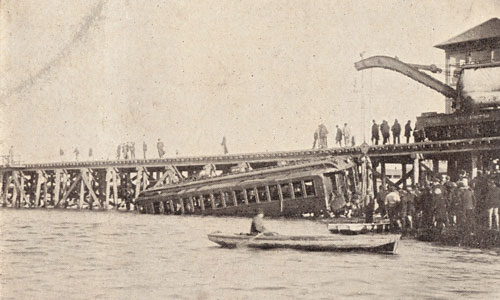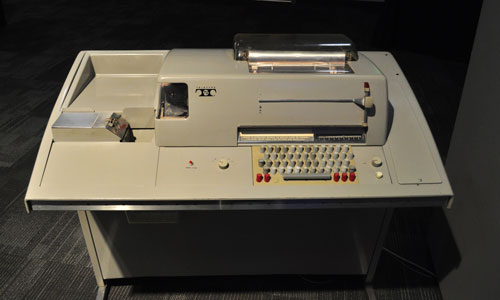The Invention Of News
The field of public relations is still built on a single foundational tool—the press release. Why do we still use them? Well, for the companies, they work.

The New York Times published the first press release word-for-word
Last week, Amtrak dealt with a deadly passenger train crash by sending out an email to its customers.
"On behalf of the entire Amtrak family, I offer our sincere sympathies and prayers for them and their loved ones. Amtrak takes full responsibility and deeply apologizes for our role in this tragic event," Amtrak President and CEO Joe Boardman wrote.
The message contained details about how the company was working to solve the problems raised by the crash, as well as how it was working to help the victims. (One of whom, by the way, is a friend of my wife's, Seyward Darby. She wrote some powerful words about the crash over this way. You should read them.)
If you dig back in the history books, you'll find that last week's Amtrak crash was far from the only passenger train disaster on the books. In fact, one such crash—with a far higher casualty toll—took place about 60 miles away from the site of the Amtrak 188 crash. Public comments from the train operators also followed that crash.
"The Pennsylvania Railroad Company is leaving nothing undone to get at the cause of the accident," the company stated.
Those public comments, from the 1906 Atlantic City train wreck, came from the first-ever press release. It was published in The New York Times, verbatim—something that would never happen today.

The first press release, borne from a guy with a tainted reputation
That release was masterminded by a guy named Ivy Ledbetter Lee, who's seen as the father of modern public relations by some.
Much like many journalists today, Lee came to PR from newspapers, quitting his press gigs because the pay sucked. Also like many journalists who switched sides, Lee was seen with suspicion by the industry he left behind.
The Times, for example, may have printed the first press release, but it wasn't long before the public relations tool fell outside its "fit to print" slogan in its unadulterated form. (Journalists were quick to arch their brows at questionable information, even during the era of Yellow Journalism.)
Lee, however, was quick to defend his PR firm's approach, writing a response, the Declaration of Principles, that emphasized the news value of the information being presented.
"In brief, our plan is frankly, and openly, on behalf of business concerns and public institutions, to supply the press and public of the United States prompt and accurate information concerning subjects which it is of value and interest to the public to know about," Lee explained.
Lee's strategy was pretty solid, and he also played key roles in creating the kind of modern public relations strategies still used today. Some of his clients were even worse than the ones Aaron Eckhart had to deal with during Thank You for Smoking. In the years before his death, he was tied to Nazi Germany due to one of his public relations campaigns, leading to a Congressional investigation.
He also was associated with an effort to soften U.S. ties with the Soviet Union during the 1920s.
On the other hand, argues Northern Kentucky University professor Michael Turney, he didn't actually know how awful either of these political forces were at the time—and that history has judged him unkindly, especially since he died before either did anything truly below reproach.
"In this context, was Ivy Lee a good guy or a bad guy? Perhaps was he just a hard-working public relations professional who suffered from bad timing and/or made a few bad choices of clients," he wrote.
Maybe it's a great irony of history that such an important PR flack needs a public relations campaign himself.
1,759
The average number of press releases sent out daily by the three largest press release services in 2013, according to an estimate by Ragan's PR Daily contributor Lou Hoffman from last August—altogether more than 600,000 that year. More press releases than ever are being sent out to fewer journalists than ever, Hoffman argues.

How PR flacks built their own versions of the Associated Press
These days, if a company wants to get a message to the press or the public, they may as well tweet it. The shorter the message, the better—it's a great way to control the conversation.
But before the age of social media, things were a bit more complicated, and at one point, news outlets had to send their press releases via the mail, which was woefully inefficient. Fortunately, a few smart folks thought of ways to get around that problem.
In 1952, the company PR Newswire began working diligently to throw a bunch of teleprinter machines into newsrooms around the country. The company worked with PR agencies to basically publish press releases verbatim on the wires.
Other companies followed suit—Business Wire put teletype machines inside of newsrooms for free, then charged their PR clients for the access to the machines.
"When I began, my one employee and I shared a 9-foot-by-12-foot room," Business Wire founder Larry Lokey told Stanford University. "We had one phone, an electric typewriter and a clattering Teletype connected via leased line to every Bay Area daily newspaper. Each of them had a Teletype I'd installed there."
(The company grew big time from there, and is now owned by Warren Buffett's Berkshire Hathaway. The 87-year-old Lokey, meanwhile, is giving away his wealth, much of it earned from the Berkshire Hathaway sale, at a breakneck pace.)
From that teletype-driven history, the services kept innovating, and are now arguably more influential than ever—they don't have to pay for ink, paper, or phone lines, but they have email instead. And goddamn, do they send a lot of emails.
The companies aren't afraid of trying new things, either. In 2001, PR Newswire threw out a multimedia display for the Michael Bay movie Pearl Harbor—the first multimedia press release of its kind.
Considering that Pearl Harbor is something of the ultimate display of bombastic commercial film, perhaps it makes sense.
"I receive more than 500 emails a day. An astonishing number of them are pitching topics that neither I nor my staff has ever covered—sent by people who’ve either never read our publication, or never read our coverage, or noticed what bylines go with what stories."
— Los Angeles Times reporter Charles Fleming, offering up a common complaint from journalists who find themselves deluged by press releases on a daily basis. Some reporters who discussed press releases with Forbes reporter Robert Wynne say they occasionally get good stuff from press releases, but TechCrunch reporter John Biggs is not one of those people. "They offer no context, no understanding of the receiver, and no story. They are literally the laziest thing a company can do," Biggs said.
Press releases exist because, ultimately, they work. For companies and marketers, they represent a simple way to expose information that isn't necessarily newsworthy on its own, but the definition of "work" is different for PR people than for journalists. If a company can get one person to bite on their press release, they've done their job.
A reporter has to parse through all the crud they find and turn it into something usable, and as a result, the signal-to-noise ratio is largely worth it for the few times there is in fact signal.
Now, there are some reporters that just hate them—and for good reason. For every reporter like Biggs who complains about press releases, there are websites that claim, excitedly, to automate the process of sending out press releases en masse—by offering search tools or ways to better target journalists. (On the other hand, this goes both ways.)
But the thing is, in 2015, you honestly don't need a press release to get your voice heard. In fact, your company would probably be better off with a blog, a Twitter account, and a willingness to write about something other than yourself every once in a while.
A good example of this kind of mindset in action is from the popular social media startup Buffer, which publishes blog posts about every social-media-related topic under the sun basically, selling the idea of itself as a great spot to find ideas about a topic near and dear to the company's heart.
Who needs a press release when you can build your own Gutenberg press for pennies on the dollar?
:format(jpeg)/2017/07/yo77umazkoqscuojzapt--1-.gif)
/2017/07/yo77umazkoqscuojzapt--1-.gif)

/uploads/ernie_crop.jpg)